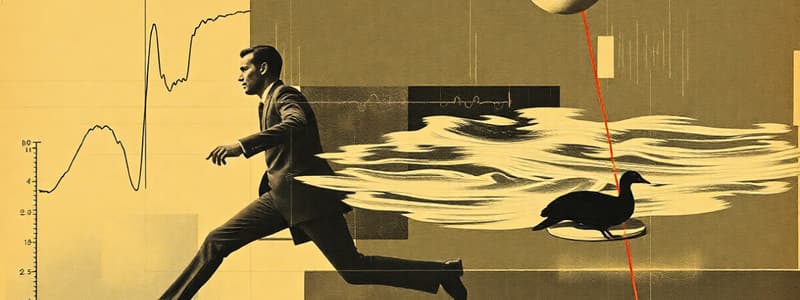Podcast
Questions and Answers
What is the sprinter's acceleration rate?
What is the sprinter's acceleration rate?
- 5.0 m/s²
- 4.0 m/s²
- 2.5 m/s²
- 3.3 m/s² (correct)
The motion detector uses light technology to measure an object's position.
The motion detector uses light technology to measure an object's position.
False (B)
What is the sprinter's top speed?
What is the sprinter's top speed?
15 m/s
In the equation for distance, the initial velocity (vo) is equal to ______.
In the equation for distance, the initial velocity (vo) is equal to ______.
Which lab equipment is used to measure an object's position?
Which lab equipment is used to measure an object's position?
Match the laboratory equipment with their functionalities:
Match the laboratory equipment with their functionalities:
What type of graphs need to be drawn after analyzing velocity vs. time graphs?
What type of graphs need to be drawn after analyzing velocity vs. time graphs?
What is the primary kinematic quantity represented by a position-vs-time graph?
What is the primary kinematic quantity represented by a position-vs-time graph?
LoggerPro software is not utilized for data collection or analysis in the lab.
LoggerPro software is not utilized for data collection or analysis in the lab.
The acceleration due to Earth's gravity at the surface is approximately 9.8 m/s² downward.
The acceleration due to Earth's gravity at the surface is approximately 9.8 m/s² downward.
What happens to the velocity of an object when it is thrown straight up?
What happens to the velocity of an object when it is thrown straight up?
The acceleration of an object in free fall is primarily due to __________.
The acceleration of an object in free fall is primarily due to __________.
Match the kinematic action with its effect on velocity:
Match the kinematic action with its effect on velocity:
During which of the following actions would an object experience a negative acceleration?
During which of the following actions would an object experience a negative acceleration?
The direction of acceleration is always the same as the direction of velocity.
The direction of acceleration is always the same as the direction of velocity.
How does the position of an object affect its velocity?
How does the position of an object affect its velocity?
What occurs to an object when friction is absent or negligible?
What occurs to an object when friction is absent or negligible?
Frictional forces always act in the direction of an object's motion.
Frictional forces always act in the direction of an object's motion.
What is the primary effect of friction on a moving object?
What is the primary effect of friction on a moving object?
The relationships between position, velocity, and acceleration can be described mathematically using _______.
The relationships between position, velocity, and acceleration can be described mathematically using _______.
Match the following kinematic aspects with their definitions:
Match the following kinematic aspects with their definitions:
Which kinematic equation relates initial velocity, final velocity, acceleration, and displacement?
Which kinematic equation relates initial velocity, final velocity, acceleration, and displacement?
The area under the curve of a velocity vs time graph represents the displacement.
The area under the curve of a velocity vs time graph represents the displacement.
How can you determine the acceleration at a particular instant from a velocity vs time graph?
How can you determine the acceleration at a particular instant from a velocity vs time graph?
What is the purpose of clicking the STAT button with '1' and '2' on it?
What is the purpose of clicking the STAT button with '1' and '2' on it?
You should measure from the side of the cart that is closest to the sensor.
You should measure from the side of the cart that is closest to the sensor.
What should you do to observe the differences between two datasets?
What should you do to observe the differences between two datasets?
The scale of your data can be adjusted by clicking the _____ button.
The scale of your data can be adjusted by clicking the _____ button.
Match the actions with the correct descriptions.
Match the actions with the correct descriptions.
What is the recommended distance to begin testing for potential dead zones?
What is the recommended distance to begin testing for potential dead zones?
It is necessary to store each trial data before hiding them.
It is necessary to store each trial data before hiding them.
What is indicated by a graph that appears as a nearly horizontal line?
What is indicated by a graph that appears as a nearly horizontal line?
What is the first action you should take before launching the cart on the track?
What is the first action you should take before launching the cart on the track?
You should not remove your hand immediately after giving the cart a push.
You should not remove your hand immediately after giving the cart a push.
What tool can be used to analyze the average acceleration of the cart?
What tool can be used to analyze the average acceleration of the cart?
The __________ of the track must be measured relative to the horizontal tabletop.
The __________ of the track must be measured relative to the horizontal tabletop.
Match the following steps with their corresponding actions:
Match the following steps with their corresponding actions:
What should be recorded in LoggerPro during C4?
What should be recorded in LoggerPro during C4?
What is required to evaluate the precision of the measurement tool?
What is required to evaluate the precision of the measurement tool?
The speed at the turn-around point is irrelevant to the experiment.
The speed at the turn-around point is irrelevant to the experiment.
Study Notes
Friction
- Friction is a force acting against the motion of objects
- Friction causes moving objects to decelerate to a stop
- Friction always acts opposite to an object's motion
Important Learning Objectives
- Describe the relationship between position, velocity, and acceleration
- Identify features of a graph: axes, slope, intercepts, maxima, minima
- Interpret a motion diagram to describe an object's behavior
- Understand the relationships between position, velocity, and acceleration in terms of calculus
- Apply the four kinematic equations to solve problems involving moving objects
- Determine velocity, acceleration, displacement, and change in velocity from graphs
- Generate graphs of position, velocity, and acceleration from one another
- Explain the acceleration due to gravity at the Earth's surface
- Explain how an object's position, velocity, and acceleration change when thrown upward, downward, or dropped
Motivation and Real-World Context
- Kinematics is the study of how objects move
- Understanding kinematics is important for preventing injuries from large accelerations or decelerations
- Kinematics is essential to biomechanics, understanding how and why the human body moves
- Kinematic data is used to create prosthetic limbs and joints
Pre-Lab Assignment:
- Position vs. Time Graph - Identify points on a graph where an object is slowing down, turning around, speeding up, stationary, moving left, moving right, and moving fastest
- Motion Diagrams - Determine the sign (+, -, or 0) of initial and final positions, velocities, and accelerations for horizontal and vertical motion based on diagram
- Sprinter Problem - Calculate:
- Time to reach top speed
- Time to complete a 100m dash
- Velocity vs. Time Graphs - Draw the corresponding acceleration vs. time graphs
- Acceleration vs. Time Graphs - Draw the corresponding velocity vs. time graphs assuming an initial velocity of 0 m/s
Lab Equipment
- Rail
- Wheeled cart
- Motion Detector (Position Sensor)
- LabQuest Mini™ computer interface
- Lab jack
- Meter stick
- Protractor
Tutorial: Motion Detection with Logger Pro
- The motion detector measures the distance to a target object
- The Logger Pro software records, displays, and analyzes data
- Learn to:
- Zero the detector
- Set the direction of the position sensor
- Start a data collection run
- Display data statistics
- Hide or display data runs
- Save data to a file
Lab Activities:
- Familiarize with Logger Pro by collecting and analyzing data
- Experiment with raising one end of the track to generate different types of motion
- Analyze the motion of a cart moving uphill and downhill on an inclined track, recording the average acceleration and uncertainty for both sections
- Graph the position, velocity, and acceleration vs. time for the motion of the cart
- Determine the speed at the turn-around point and the acceleration during the uphill and downhill motions
Studying That Suits You
Use AI to generate personalized quizzes and flashcards to suit your learning preferences.
Related Documents
Description
Explore the concepts of friction and kinematics in this comprehensive quiz. Understand the relationships between position, velocity, and acceleration, and learn to interpret motion diagrams and graphs. Test your knowledge on kinematic equations and how they apply to real-world scenarios.




